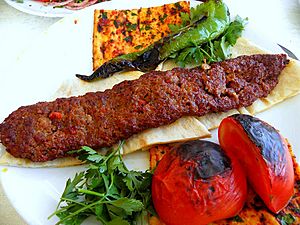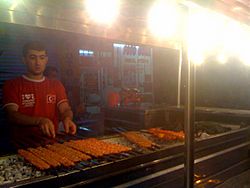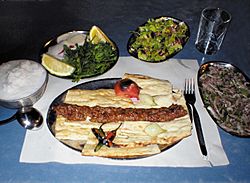Adana kebabı facts for kids
Adana kebabı is a famous Turkish dish. It's made from long, hand-minced meat, usually lamb. This meat is shaped onto a wide iron skewer and then cooked over a grill called a mangal, which is filled with burning charcoal.
The dish gets its name from Adana, which is the fifth largest city in Turkey. It was originally known as "Kıyma kebabı," meaning "minced meat kebab," or simply "Kıyma" in the Adana-Mersin area and southeastern Turkey. It's quite similar to a dish called kabab koobideh from Iranian cuisine.
Contents
History
Kebabs are often made from ground lamb meat and tail fat, but there are many different versions depending on the region. This type of kebab is common in areas stretching from Mersin in Turkey to Kirkuk in Iraq, including Aleppo in Syria.
Many people believe this kebab came about by mixing Turkish and Arab cooking styles. Some say it was first created in Birecik, an important place in the past. The Adana kebabı we know today has a history rooted in modern Turkish culture. In 2005, it received a special "Controlled Designation of Origin," which means only kebabs made in a specific way in Adana can be called Adana kebabı.
Where it's Found
Original Locations
To be called an original Adana kebabı, it must be made by a seller who has passed a special check by the Adana Chamber of Commerce.
The Kıyma kebabı is still made in its traditional areas. Similar dishes are also prepared in nearby parts of Turkey, Syria, and Iraq. In these places, the meat is hand-ground with tail fat and sometimes a mild pepper.
Newer Versions and What People Think
Since the 1950s, new kinds of Kıyma kebabı have become popular in places that were once part of the Ottoman Empire, like Istanbul, Baghdad, and Damascus. These versions are changed to fit local tastes and are not considered the original Kıyma kebabı.
For example, in Istanbul and other Turkish cities outside of Adana and Aleppo, a Kıyma kebabı is either called "Adana kebabı" (the spicy one) or "Urfa kebabı" (the non-spicy one). However, the original Adana kebabı was not spicy at all, and "Urfa kebabı" didn't even exist in Urfa originally.
How it's Made
Mincing and Mixing
According to its special designation, Adana kebabı is made from the meat of a male lamb less than one year old. The lamb must have grown up naturally and eaten local plants.
First, the meat is cleaned to remove any tough parts or extra fat. Then, it's cut into rough pieces. Tail fat is added, about one part fat to five parts meat. This mixture rests for a day.
The next day, the meat and fat are hand-ground using a special crescent-shaped knife called a "Zırh". Only sweet red peppers (also hand-chopped with the Zırh) and salt are added. Sometimes, spicy green peppers and fresh garlic can also be included.
Finally, the meat, fat, salt, and other ingredients are mixed very well until they form a smooth, even paste.
Putting it on Skewers
Once the meat mixture is ready, it's placed onto iron skewers. These skewers are about 0.5 cm thick, 3 cm wide, and 90 to 120 cm long. A single serving of Adana kebabı usually has about 180 grams of meat on one skewer. A "portion-and-a-half" uses slightly wider skewers and has at least 270 grams of meat.
Adding a little water helps the minced meat stick to the skewer. This is the trickiest part of making the kebab. If a skilled Usta (chef) doesn't do it right, the meat might fall off the skewer while cooking.
Cooking
The skewers with the meat are cooked over hot, flame-less coals, usually from oak wood. The skewers are turned often. The kebab is ready when the meat turns a dark brown color. As the fat melts, it's collected on flatbread by pressing pieces of bread against the cooking meat. This also helps to warm the bread.
How to Serve and Eat It
The kebab is usually served in two ways: on a plate as a "Porsiyon" or wrapped in flatbread as a "Dürüm".
Porsiyon (Plate Serving)
When served as a "Porsiyon", the kebab is placed on flatbread that has soaked up the meat drippings. It comes with roasted tomatoes, green or red peppers, and thinly sliced onions mixed with parsley and sumac.
Other common side dishes in Adana-Mersin include red pepper paste with pomegranate syrup, fresh mint and tarragon leaves, cooked shallots with olive oil and pomegranate syrup, and pickled small green chili peppers. Around Mersin, you might also find green shallot stems with slices of bitter orange, citron, lime, and lemon. Many restaurants in Adana also serve warm hummus topped with butter and pastırma on the side.
To eat a "Porsiyon", you peel and mash the grilled tomatoes and peppers into a paste. You then put some of this paste on a piece of flatbread with part of the kebab. Add a good amount of the onion-sumac-parsley mix, and then wrap it all into small, thick rolls called dürüms.
Ayran (a yogurt drink) and Şalgam (a turnip juice drink) are popular drinks with kebab during the day.
Dürüm (Wrapped Roll)
For a "Dürüm", the cooked kebab is taken off the skewer and placed on a large piece of flatbread, usually lavash or tırnak pidesi. It's topped with sliced onions, small diced tomatoes, some parsley, and a sprinkle of salt, cumin, and sumac. Then, it's rolled into a long wrap. Ayran is often preferred with dürüm more than Şalgam.
Different Kinds of Kebab
Many different versions of Kıyma kebabı exist. They are all made from hand-chopped lamb meat and tail fat. You can find them in the Cilician and Mesopotamian regions that were once part of the Ottoman Empire.
Here are a few examples:
Adana-Mersin Area
- Metrelik kebap: This is a newer specialty from famous chefs in Adana. It's a very long and thick Kıyma kebabı, from 1 to 10 meters long, depending on how many people are eating. The iron skewers for this are specially made to be long and heavy.
- Beytî: This is a version inspired by the famous Beyti from Istanbul. Instead of peppers, parsley and fresh garlic are chopped with the meat and fat.
- Kebab Tarsûsî: More common in Tarsus, this Kıyma kebabı only includes minced onion with the meat and fat.
Gaziantep - Aleppo - Şanlıurfa Area
- Haşhaş kebabı or كباب خشخاش: Very popular in Nizip, Urfa, Birecik, and Aleppo. This is a simple Kıyma kebabı that sometimes has a hint of caul fat and crushed walnuts, making it a bit crispier.
- Simit kebabı (Antep), oruk kebabı (Kilis) or كبّة مشويّة (Halep): This is a distant relative of Kıyma kebabı. For every kilogram of meat, it includes a glass of soaked bulgur, a few shallots, 30 grams of pine nuts, and only 100 grams of tail fat. Different herbs and spices like dried mint, paprika powder, sumac, and cumin can be added for flavor.
- Fıstıklı kebap: A specialty from Antep that has about 150 grams of coarsely ground pistachio nuts for every kilogram of meat and fat.
- Sebzeli kebap: Another specialty from Antep where red and green peppers, onions, and parsley are hand-chopped together with the meat and fat.
- Süleymâniye Kebabı or كباب سليمانية: An Iraqi version that is different from the classic Adana kebabı. No pepper or spice is added to the meat mixture. It's cooked on a special mangal that has a strong fan, which makes the charcoal very hot. This creates a unique and tasty Kıyma kebabı with a crispy outer layer. It's named after the city of Sulaymaniyah in Iraqi Kurdistan.
Events
Since 2010, Adana kebabı has been celebrated at a festival in Adana. The Adana Kebab and Şalgam Festival grew from a hundred-year-old tradition of enjoying kebab with liver, şalgam, and rakı. This event has become a popular street festival across the country. Street musicians play drums and zurna, entertaining visitors all night long on the second Saturday of every December.
Images for kids
See also
 In Spanish: Adana kebab para niños
In Spanish: Adana kebab para niños













